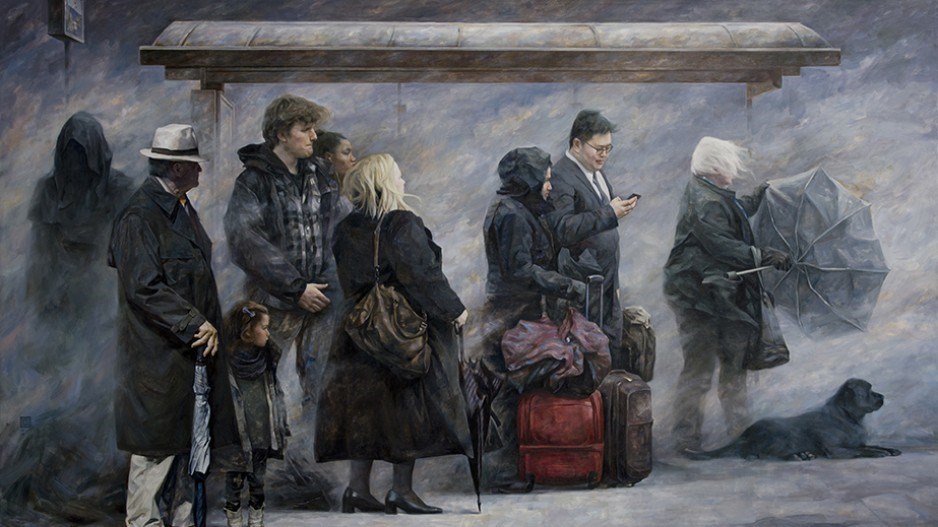With China’s rising wealth driving new interest in art collecting, many Chinese-Canadian artists are re-establishing links to Asia after emigrating in the 1980s and ’90s due to a lack of domestic demand.
A new sign of this artistic rapprochement is Poly Culture North America’s Lingering Charm exhibition, which began its three-month run at the company’s Vancouver gallery on June 12. It will feature 25 pieces from renowned artist Xue Yanqun, who found fame in the mid-1980s as one of the first contemporary art talents to emerge from China after the Cultural Revolution.
Xue is now a Canadian citizen and has lived in Metro Vancouver since moving here in 1997. Some of his newer work now reflects a unique Chinese-Canadian perspective on subjects such as the city’s Downtown Eastside, and the exhibition’s organizers say it was this East-West mixture that attracted them to the idea of featuring Xue.
The exhibition reflects Poly Culture’s expanding transpacific role as it seeks to bridge Chinese and North American culture.
“We’ve held 10 exhibits in Vancouver now, and historically, they are from Asia – rare pieces that have rarely had the chance to be shown in North America, let alone here in Canada,” said Poly Culture North America CEO Chen Yi. “But I think part of our duty of being here in Canada is that we should serve as a gateway to exchange in both directions. When you have an artist like master Xue, I think the opportunity is here to showcase that talent to the audience here in Vancouver and beyond that may not be aware.”
For Xue, working with Poly, the local branch of China’s biggest auction house, is the first step in getting his newer, Canada-influenced work back into the Chinese market that he left two decades ago. Both Xue and Chen said plans are underway to bring the show to Chinese cities after its Vancouver run ends on Sept. 12.
Speaking from his home studio in Richmond, Xue said he didn’t think he would rekindle his relationship with the Chinese market until recently, when he met with new Chinese immigrants whose level of interest in art was something he hadn’t seen before.
“When we left China, we thought we were leaving behind our fame in the domestic market for a fresh start here in Canada,” Xue said. “And I’ve been very fortunate that we’ve been able to sell art through some galleries here to patrons from as far away as Alberta…. But as more Chinese people moved here, the more they rediscovered my work and came into contact with me, and I think with their large market, it makes sense to work on this right now.”
According to a 2017 report on China by the Art Market Monitor of Artron (AMMA), the average auction price of all oil paintings and contemporary art in the Chinese market last year reached US$143,000, compared with the US$93,000 reported in 2014. Three paintings sold for a hammer price of above US$20 million, and the oil painting category now makes up 10% of China’s total art auction market.
The report further notes the market’s apparent preference for artists with Chinese heritage or links. Of the top 100 pieces sold in 2017, there were 28 oil paintings, 23 of which were created by Chinese artists.
“Collectors have recognized the works by Chinese artists,” the report said. “They [collectors] are willing to offer high prices for works with high academic value or for iconic works by masters…. With the increase in appreciation and the development of connoisseurship in society, the future of [the] Chinese oil painting market will become more stable and steady.”
The Chinese Artists Association in Vancouver counts more than 250 active members, and its component groups of artists have been in existence since the 1990s.
Beyond achieving sales, Xue said he has an additional goal – one with a social dimension. Xue, whose painting has often mixed Renaissance-period Italian techniques with Chinese subjects and themes, intentionally went in another direction in some of his newer works to achieve another type of East-meets-West effect.
Xue said his works have the aim of promoting a conversation between communities, especially the paintings with a focus on Vancouver’s Downtown Eastside, a neighbourhood that bears a stigma for wealthy new immigrants from the Chinese community.
Xue hopes his paintings, which present the people in the neighbourhood in a realistic but dignified way, will open the eyes of Chinese visitors and new immigrants to Canada, to encourage newcomers to Vancouver to see the city with a more mature, well-rounded perspective.
“I think the majority of the Chinese community here avoid East Hastings as much as possible, because it scares them a little bit,” Xue said. “But these are just people who choose another way of life…. I used to paint only Chinese subjects, but you need to see all aspects of the society where we live. Painting subjects like this – it’s a way for us as Chinese-Canadians to step out of our circles and not be continually mired in our own comfort zones.”
Poly officials have expressed a desire to broaden the organization’s involvement with Vancouver’s art scene. Last summer, it was one of the main sponsors of the Claude Monet’s Secret Garden exhibition at the Vancouver Art Gallery.




